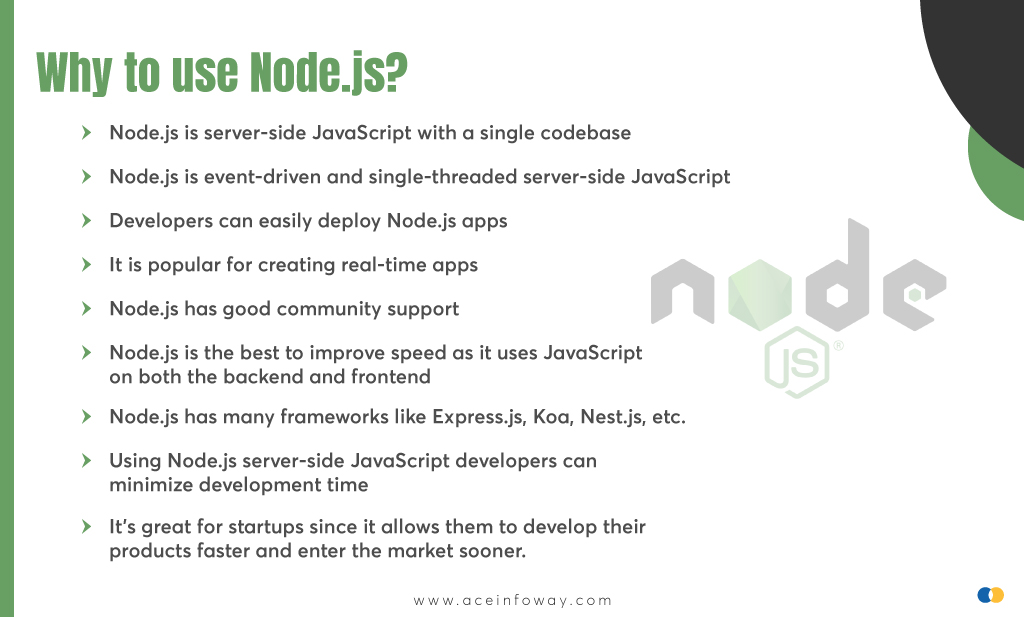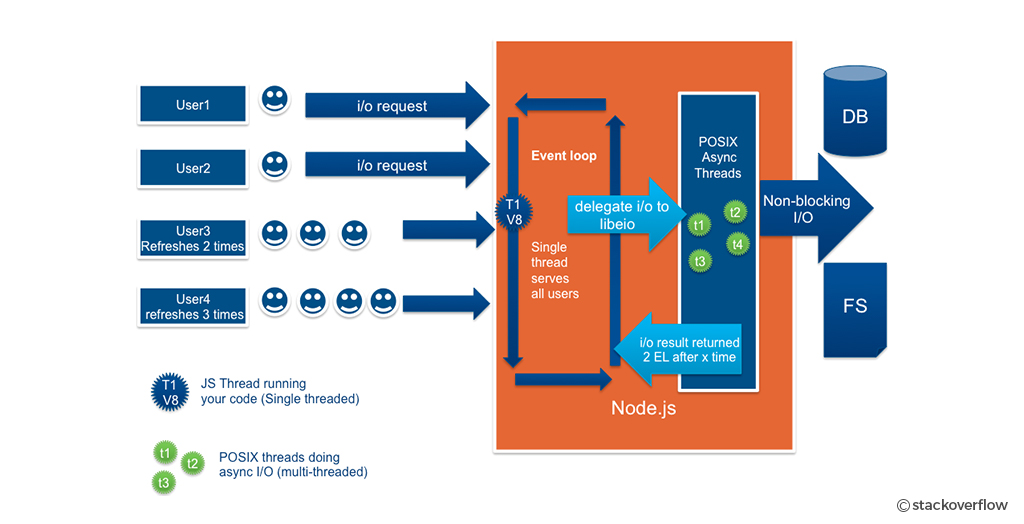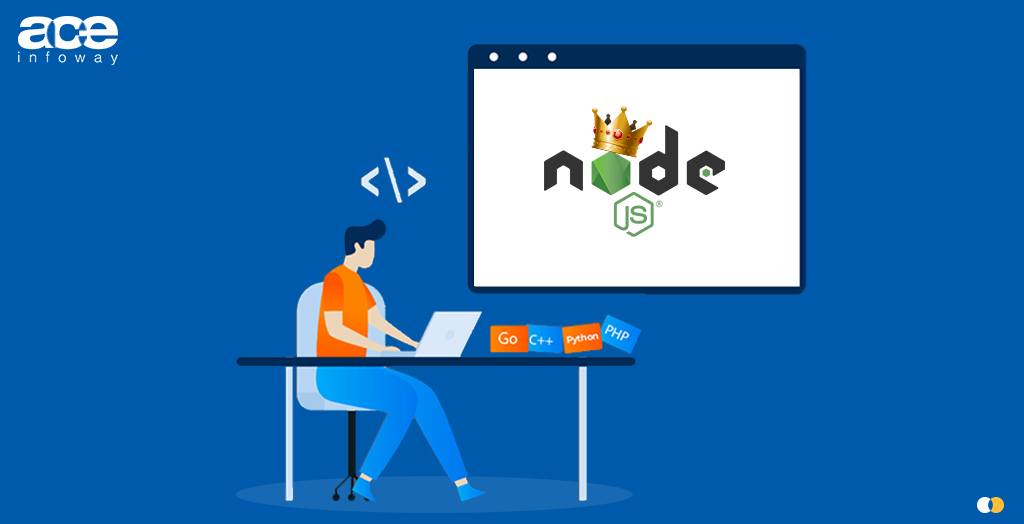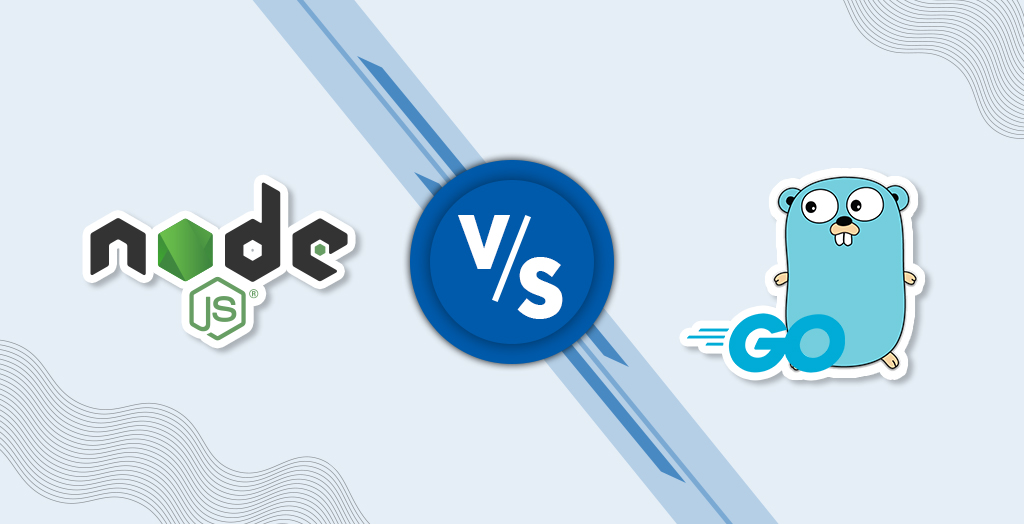Table of Contents
One of the most widely used programming languages is JavaScript. According to Statista, JavaScript is the most popular programming language used by software developers globally in the last 12 months, according to 69% of those surveyed.
Without JavaScript, any discussion of web development is insufficient.
Similarly, any discussion of JavaScript would be inadequate without mentioning Node.js.
With time, however, Node.js has moved beyond “web development” and into areas such as API development and mobile app development.
Even after all this time, there is still a widespread misconception regarding Node.js; that it is a framework.
But the fact is, that Node.js is a runtime environment based on the V8 engine from Google Chrome.
Node.js has come to prominence at an incredible rate, and the reason for this is because, similar to how Angular filled the void of client-side scripting, Node.js filled the void of server-side scripting, and even featured capabilities that could help connect the client and server-sides.

Node.js Performance Checklist
Get your free copy
What is Node.js?
Ryan Dahl was the first to launch Node.js in 2009. Node.js is an open-source, cross-platform JavaScript runtime environment, with a focus on server-side and networking applications.
As Node.js is open source, it is free to use and is continually being updated and improved by a global community of developers.
Node.js allows developers to create fast, scalable network applications with simple code. It’s compatible with Windows, Mac OS X, Linux, Unix, and other operating systems.
Node.js is built on Chrome’s V8 JavaScript engine. It allows JavaScript users to execute server-side scripting and run programs to dynamically generate web content. The Node.js environment is more of a run-time environment.
A runtime environment (also known as an RTE) is a collection of Web APIs that a developer can use to create code, as well as a JavaScript engine that parses that code. This makes it lightweight, adaptable, and simple to deploy, all these features will aid in the optimization and speed up your application project. It employs a non-blocking I/O approach and has an event-driven model. It’s perfect for real-time and data-intensive applications.
What is Node.js used for?
Node.js is a platform that is built on Chrome’s JavaScript runtime to easily build fast and scalable network applications. Node.js is primarily used as an asynchronous event-driven JavaScript runtime due to its single-threaded nature. It is used for traditional websites and back-end API services but was built with a real-time, push-based architecture in mind.
Node.js is used in many different applications. Let’s look at some common scenarios where Node.js is a good fit:
- Real-time Chats: Node.js is well-suited to handling real-time communication due to its single-threaded asynchronous nature. It’s scalable and frequently used in chatbot development. Additional chat features like multi-person chat and push alerts are similarly simple to implement with Node.js.
- Internet of Things: IoT applications commonly use numerous sensors, as they often send small pieces of data that can accumulate into a huge number of requests. Node.js is a fantastic choice because it can handle these concurrent requests rapidly.
- Data Streaming: Netflix and other streaming services use Node.js. This is mainly because Node.js is lightweight and fast and also provides a native streaming API. Users can pipe requests to each other over these streams, resulting in data being streamed directly to its final destination.
- Complex Single Page Apps: The entire app is loaded on a single page in SPAs. This usually signifies that a few requests for certain components are being made in the background. The event loop in Node.js comes to the rescue here, processing requests in a non-blocking manner.
- REST API Based Applications: Both the frontend and backend of websites use JavaScript. Using Node.js, a server may simply communicate with the frontend using REST APIs. Node.js also includes packages like Express.js and Koa that make developing web apps much easier.
However, there are various other reasons why you should use Node.js:
- Node.js is server-side JavaScript with a single codebase
- Node.js is event-driven and single-threaded server-side JavaScript
- Developers can easily deploy Node.js apps using Node.js web hosts
- It is popular for creating real-time apps
- Node.js has good community support
- Node.js is the best to improve speed as it uses JavaScript on both the backend and frontend
- Node.js has many frameworks like Express.js, Koa, Nest.js, etc.
- Using Node.js server-side JavaScript developers can minimize development time
- It’s great for startups since it allows them to develop their products faster and enter the market sooner.

What Does Node.js Do?
Many web frameworks use JavaScript as their base. Angular and React, Meteor.js, Vue.js, and others are among them. They all help to speed up the development process by improving efficiency, safety, and cost-effectiveness. Node.js is not a JS framework; it allows you to create platform-independent web apps. The tool’s official description or title is “run-time environment,” which implies a broader implementation scope.
Node.js uses are not limited to only web apps but also include microcontrollers, REST APIs, static file servers, OS wrappers, robots, and even drone programming. Rather than a listless request-reply message exchange pattern, the technology uses a progressive event-driven paradigm, which creates an event loop that is ready to react to an occurrence.
In a simple way,
- Node.js dynamically generates page content.
- On the server machine, Node.js generates, opens, reads writes, deletes, and closes files.
- Node.js also collects form data.
- Node.js updates databases by adding, deleting, and modifying data.
- Node.js can be used smoothly by both backend and frontend developers.
- Node.js makes it easier to create high-traffic, real-time apps like gaming and chats.
- Node.js allows developers to write JavaScript code on both the server and client side.
- Compared to other languages, Node.js code execution is faster.
- The rapidly expanding Node Package Manager (NPM) provides developers with a variety of modules and tools to help them work more efficiently.
What is Node.js Server-side JavaScript?
JavaScript is a programming language that can be used for writing scripts on a website. Node.js is a runtime environment for JavaScript. JavaScript can only run in the browsers but with the help of Node.js, we can run JavaScript outside of the browser.
SSJS (Server-Side JavaScript) is a JavaScript extension that allows back-end access to databases, file systems, and servers. Server-side Javascript is JavaScript code that runs over local server resources, similar to C# or Java, but with JavaScript syntax. Node.JS is a nice example of this; with Node.JS, you may code on the server-side using JavaScript, and that code can be viewed as conventional C#, C, or any other server-side language code.
Furthermore, you can send JavaScript to the client-side with server-side code, but there is a significant difference between the two because client-side code is limited to the client’s machine resources in terms of computing power and permissions. Client-side JavaScript, for example, cannot access the client’s hard disc, whereas server-side JavaScript can access the server’s hard disc without issue.
The ability to highly modify the response based on the user’s requirements, access rights, or queries into data storage is the fundamental benefit of server-side scripting.
Node.js Server-Side JavaScript Process
 While working with the request, Node.js accepts requests from clients and sends responses. They are handled by a single thread in node.js. Threads are used by Node.js to handle I/O operations and requests. A thread is a set of instructions for the server to execute. It runs in parallel on the server to provide data to several clients. Node.js is an event loop single-threaded language. With a single thread, it can handle multiple requests without blocking it for one.
While working with the request, Node.js accepts requests from clients and sends responses. They are handled by a single thread in node.js. Threads are used by Node.js to handle I/O operations and requests. A thread is a set of instructions for the server to execute. It runs in parallel on the server to provide data to several clients. Node.js is an event loop single-threaded language. With a single thread, it can handle multiple requests without blocking it for one.
Node.js is based on two concepts.
- Asynchronous
- Non-blocking I/O
Why Node.js is the Most Popular Server-Side JavaScript?
Netflix, Paypal, Uber, etc are some of the big giants that have implemented Node.js and have grown considerably in size. Given its popularity among software developers, it is realistic to assume that Node.js will continue to expand at a similar rate in the future.
It is one of the best server-side JavaScript runtime environments among developers and companies because:
- It is easy to learn
- Highly scalable
- Node.js is light and fast
- Full-stack JavaScript
- Cross-platform development
- Active community
Conclusion
In a nutshell, Node.js is a popular JavaScript runtime environment for building high-scale apps that supports multiple concurrent requests. Its non-blocking single-threaded I/O makes it ideal for both real-time and data streaming applications.
Since its introduction in 2009, Node.js has risen to become one of the most demanded technologies, indicating that it is extremely powerful. Node.js has become a solution to many difficulties by providing security, scalability, and performance.
At Ace Infoway, we’re experts in understanding all the latest trends, technology, and nuances of frontend development. We’re on a mission to empower businesses with the expertise they needed to scale, succeed, and build a better digital ecosystem. If you have any questions about Node.JS developers, do get in touch with our skilled team and clear all your doubts and queries. Get our Node.js Development Services to create your next web or mobile app.

























